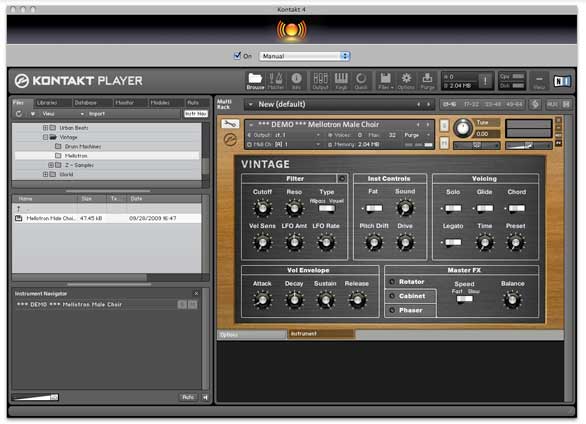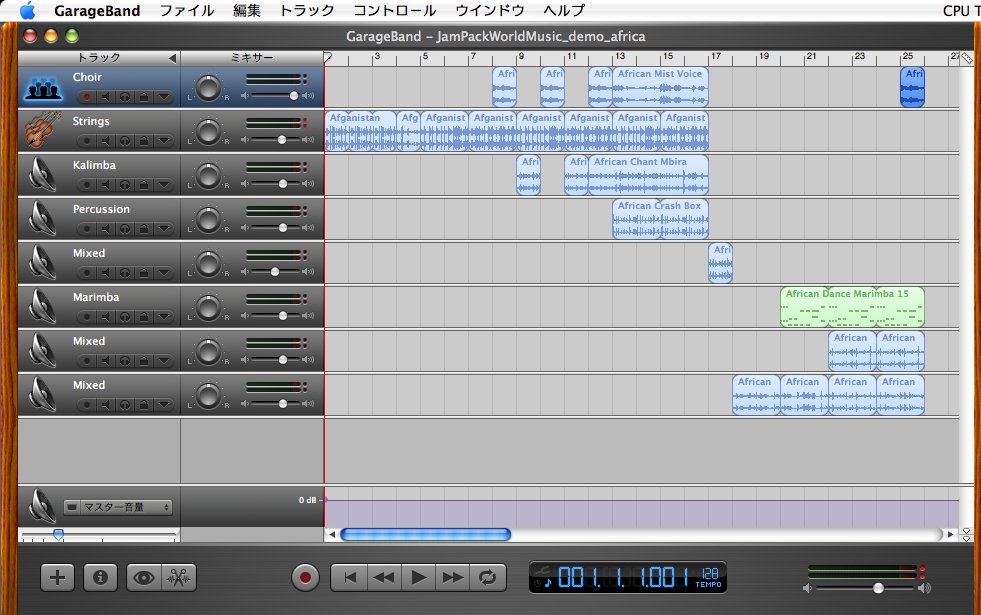[ITEM]

 [/ITEM]
[/ITEM]


Garageband Jam Pack Symphony Torrent Rating: 5,0/5 9661 reviews

The big news for live performers is multi-track recording. Every track now has a 'enable or disable recording' option (just to the left of mute and solo). You can enable recording for up to eight Real Instrument tracks and optionally one Software Instrument track. You'll need an audio interface, a serious one for eight simultaneous tracks; someone who's got one, please let us know how well it works. There are more new features for live performers.
After you've recorded a track, there are sliders in the track editor to 'enhance' the timing (nudge the notes closer to a specified beat) or pitch (get monophonic notes closer to a true note, or an in-key note). This isn't like the Software Instrument 'Align to' button, which modifies the track; instead, it controls how the track is played. You can adjust the pitch of any region, the way you used to be able to transpose a Software Instrument region. (I'm not sure how you can now transpose individual notes, at least not in piano roll view.) There a new 'Vocal Transformer' effect with presets such as 'Male to Female', 'Down Minor Third', 'Chipmunk', and 'Monster'. Last but not least, when you adjust the tempo of a song, Real Instrument regions now speed up and slow down, just like loops and Software Instruments.
(If you open an existing song, your purple regions will now be orange, and can't take advantage of these tricks. If you join orange regions, the result is a purple region. Thanks to Jeff Tolbert, author of the 'Take Control' GarageBand e-books, for mentioning this in the Apple GarageBand discussion boards.) A song with several Software Instrument tracks used to lead to the dreaded message, 'Some parts were not played.' A Software Instrument track can now be 'locked'; the next time you play it, the track will be rendered ahead of time, making it very easy for GarageBand to play. A friend had a song with eight Software Instrument tracks and some drum loops, that always overloaded his PowerBook. When I took the song and locked some tracks, I could play it on my iBook without the play head ever changing color. The on-screen keyboard has a new friend, the 'Musical Typing' keyboard. Inf installer tool.
You can control pitchbend, modulation, velocity, and sustain, all from your QWERTY keyboard. You can control which octave you can play, but at any given time you only can play from C to the F an octave and a half up. I might not permanently retire MidiKeys. The classic keyboard can still be resized to be wider, but now it can also be resized vertically so the keys are bigger.
Jul 4, 2017 - 2023 by Talking Business. Proudly created with Wix.com. Grey Google+ Icon Grey Twitter Icon. Grey LinkedIn Icon. Grey Facebook Icon.
Mac' LeVitus pointed this out at Mac Observer.) Software Instrument tracks can now be displayed and edited in piano roll format or music notation. Music notation has some keyboard shortcuts for moving and transposing notes. I haven't figured out how to change the length of a note in music notation. There also seems to be some disconnect between the two views.
David Hamilton is best known for his soft focus, dreamy, grainy style of his images, David Hamilton set the fine arte photography aesthetics of his time. The soft focus and muted colours, the lines created by the human form and captured by Hamilton are beautiful and representative of his style. Nov 25, 2016 David Hamilton I Photographer David Hamilton found dead in Paris The British photographer David Hamilton has died at the age of 83, according to French police. A police source told Reuters that. Hamilton, David - Photographer, Director, UK - *- with actresses during the making of the movie 'Tendres Cousines' - 1980. Nov 28, 2016 David Hamilton, the British photographer whose diaphanous images of prepubescent girls blurred the line between art and pornography, was.  David Hamilton was a British photographer and film director known for his nude photographs of adolescent girls. Often controversial, the images evoke an.
David Hamilton was a British photographer and film director known for his nude photographs of adolescent girls. Often controversial, the images evoke an.
What appear to be perfectly aligned quarter notes on the piano roll don't look that way in notation. Rolled chords and glissando notes also seem to lose some information in notation view.
- Author: admin
- Category: Category
Search
Top Articles
- Kernigan D Ritchi Yazik Programmirovaniya Si Pdf
- Qualcomm Hs Usb Qdloader 9008 Driver Windows 7
- Template Baju Vector
- Crystal Reports 9 Runtime Installer Download
- Uzornaya Dlya A4
- Multicharts 87 Crack
- Command And Conquer Generals Zero Hour Keygen Free Download
- Hannstar K Mv 4 94v 0 Manual
- Deep Fritz 12 Keygen Download
- Designaknit 7 Professional
- Testi Po Grazhdanskomu Pravu Osobennaya Chastj S Otvetami

Garageband Jam Pack Symphony Torrent Rating: 5,0/5 9661 reviews

The big news for live performers is multi-track recording. Every track now has a 'enable or disable recording' option (just to the left of mute and solo). You can enable recording for up to eight Real Instrument tracks and optionally one Software Instrument track. You'll need an audio interface, a serious one for eight simultaneous tracks; someone who's got one, please let us know how well it works. There are more new features for live performers.
After you've recorded a track, there are sliders in the track editor to 'enhance' the timing (nudge the notes closer to a specified beat) or pitch (get monophonic notes closer to a true note, or an in-key note). This isn't like the Software Instrument 'Align to' button, which modifies the track; instead, it controls how the track is played. You can adjust the pitch of any region, the way you used to be able to transpose a Software Instrument region. (I'm not sure how you can now transpose individual notes, at least not in piano roll view.) There a new 'Vocal Transformer' effect with presets such as 'Male to Female', 'Down Minor Third', 'Chipmunk', and 'Monster'. Last but not least, when you adjust the tempo of a song, Real Instrument regions now speed up and slow down, just like loops and Software Instruments.
(If you open an existing song, your purple regions will now be orange, and can't take advantage of these tricks. If you join orange regions, the result is a purple region. Thanks to Jeff Tolbert, author of the 'Take Control' GarageBand e-books, for mentioning this in the Apple GarageBand discussion boards.) A song with several Software Instrument tracks used to lead to the dreaded message, 'Some parts were not played.' A Software Instrument track can now be 'locked'; the next time you play it, the track will be rendered ahead of time, making it very easy for GarageBand to play. A friend had a song with eight Software Instrument tracks and some drum loops, that always overloaded his PowerBook. When I took the song and locked some tracks, I could play it on my iBook without the play head ever changing color. The on-screen keyboard has a new friend, the 'Musical Typing' keyboard. Inf installer tool.
You can control pitchbend, modulation, velocity, and sustain, all from your QWERTY keyboard. You can control which octave you can play, but at any given time you only can play from C to the F an octave and a half up. I might not permanently retire MidiKeys. The classic keyboard can still be resized to be wider, but now it can also be resized vertically so the keys are bigger.
Jul 4, 2017 - 2023 by Talking Business. Proudly created with Wix.com. Grey Google+ Icon Grey Twitter Icon. Grey LinkedIn Icon. Grey Facebook Icon.
Mac' LeVitus pointed this out at Mac Observer.) Software Instrument tracks can now be displayed and edited in piano roll format or music notation. Music notation has some keyboard shortcuts for moving and transposing notes. I haven't figured out how to change the length of a note in music notation. There also seems to be some disconnect between the two views.
David Hamilton is best known for his soft focus, dreamy, grainy style of his images, David Hamilton set the fine arte photography aesthetics of his time. The soft focus and muted colours, the lines created by the human form and captured by Hamilton are beautiful and representative of his style. Nov 25, 2016 David Hamilton I Photographer David Hamilton found dead in Paris The British photographer David Hamilton has died at the age of 83, according to French police. A police source told Reuters that. Hamilton, David - Photographer, Director, UK - *- with actresses during the making of the movie 'Tendres Cousines' - 1980. Nov 28, 2016 David Hamilton, the British photographer whose diaphanous images of prepubescent girls blurred the line between art and pornography, was.  David Hamilton was a British photographer and film director known for his nude photographs of adolescent girls. Often controversial, the images evoke an.
David Hamilton was a British photographer and film director known for his nude photographs of adolescent girls. Often controversial, the images evoke an.
What appear to be perfectly aligned quarter notes on the piano roll don't look that way in notation. Rolled chords and glissando notes also seem to lose some information in notation view.
Search
Top Articles
- Kernigan D Ritchi Yazik Programmirovaniya Si Pdf
- Qualcomm Hs Usb Qdloader 9008 Driver Windows 7
- Template Baju Vector
- Crystal Reports 9 Runtime Installer Download
- Uzornaya Dlya A4
- Multicharts 87 Crack
- Command And Conquer Generals Zero Hour Keygen Free Download
- Hannstar K Mv 4 94v 0 Manual
- Deep Fritz 12 Keygen Download
- Designaknit 7 Professional
- Testi Po Grazhdanskomu Pravu Osobennaya Chastj S Otvetami